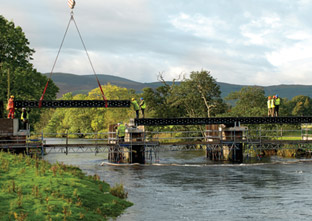
Daringly innovative composites
Robust, low-cost plastic bridges
On 29 October 2002, a 34 ton Sherman tank rolled across West Mill Bridge in Oxfordshire, UK. Not for a war film but for load testing before the commissioning of Europe’s first composite vehicle bridge.
Previously, the only composite structures built had been footbridges. With this vehicle bridge, fibreglass-reinforced plastic showed it could rival traditional reinforced concrete bridges. Its big advantage is that structures can be prefabricated, making them easier to erect, saving time...and reducing traffic disruption.
Built with this in mind, the Friedberg Bridge was erected in less than a week in 2008, in Hesse, Germany.

 It comprises a fibreglass deck bonded to two steel beams and covered with a polymer (epoxy resin and silicate) concrete flooring. Although 27 m long and 5 m wide, it weighs in at only 80 tons.
It comprises a fibreglass deck bonded to two steel beams and covered with a polymer (epoxy resin and silicate) concrete flooring. Although 27 m long and 5 m wide, it weighs in at only 80 tons.
More surprising still, the first recycled plastic bridge in Europe was opened in late 2011 on the River Tweed in Wales. Designed for motor traffic, it was built using fifty tons of water bottles and erected in just two weeks.
Composites - bridging present and future
 Are composites destined to replace the steel cables on suspension bridges? From a technical viewpoint, there is no reasonnot to. They are perfectly suited to the configuration of this type of permanent structure.
Are composites destined to replace the steel cables on suspension bridges? From a technical viewpoint, there is no reasonnot to. They are perfectly suited to the configuration of this type of permanent structure.
Composite cables have a very high tensile strength and fatigue resistance, present no buckling risk, and are corrosion-resistant. Their light weight, with a density one-fifth that of steel, is a clear advantage.
A pioneer in many things, Japan led the way in 1977 by strengthening over 500 metres of the Kurushima Bridge with composite cables. The technique is well-suited to earthquake risk areas and was subsequently used for the entire cable-staying of thirty suspension bridges in the archipelago.
Also adopted in North America, it was introduced later in Europe. Firstly in Switzerland in 1996, for the composite cable-stayed Winterthur vehicle bridge, equipped with an optical fibre monitoring system. Next came the Herning footbridge in Denmark in 1999. Most recently, a composite cable-stayed bridge was built at Laroin in the French Pyrenees in 2002.
Where will the next challenge come from? A clue may be had from researchers’ blue-sky thinking for the construction of a suspension bridge over the Strait of Messina (3300 metres). Their modelling showed it would require about 156,000 tonnes of steel cables but only 10,000 to 15,000 tonnes of composite. The only hitch is that this represents nearly half of world composite production...A bit much really for just one bridge!






